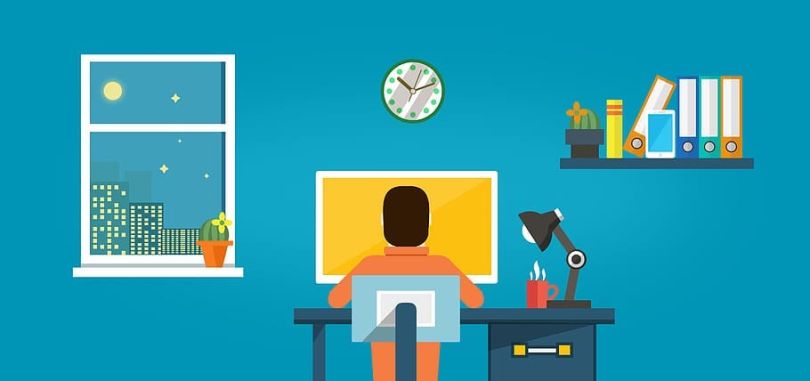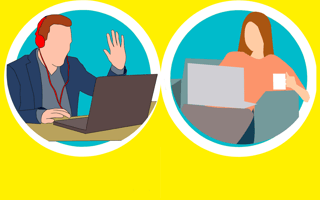Remote work might make commuting easier, but it makes communicating harder.
Just asked Jerry Low, a Vancouver-based full-stack software engineer for Toronto software studio Myplanet. For Low, remote work was no problem — he’d been collaborating with the same coworkers for years — but large company meetings were a pain.
He couldn’t get his questions answered, because he had no way to raise his hand or get the room’s attention. Then, if he did get the opportunity to speak, his too-loud-or-too-quiet computer mic made things awkward. He was annoyed— and his teammates were too.
So he spent three weeks coding in the evenings with two of his colleagues: director of product strategy Katie McCoy and visual interface designer Amit Jakhu. They emerged with an MVP: Askaway, a remote work tool that collects questions during meetings to make sure in-person attendees don’t always get first dibs. MyPlanet started using it across the company, and Low’s problem was solved.
Now, Myplanet has made Askaway’s code open source. It’s only received a handful of downloads so far, CEO Jason Cottrell told Built In in an email, but its creators think it has the potential to make future distributed or co-located workplaces more equitable.
Plenty of engineers have side projects, but few of them permanently change the way their companies operate. As the shift toward remote work introduces new challenges, here’s some advice from Askaway’s creators on how engineers can use side projects to make work better for everyone.
Ingredients of an Impactful Side Project:
- Treat your coworkers like customers. Unexpected user stories could change the direction of your project.
- Plan for multiple releases. Collect and incorporate feedback, even if that means accepting you didn’t nail it the first time.
- Stick with people and projects you care about. You’re building this on your own time, so don’t torture yourself, please.

Treat Your Coworkers Like Customers
Conversations with coworkers helped McCoy, Low and Jakhu figure out what Askaway really needed. As is often the case in development processes, they found that the first story wasn’t the whole story.
Initially, they talked with remote employees and brainstormed ways someone off site could “raise their hand” in a large meeting — would it be a flashing light in the room? Some sort of sound cue to alert the presenter that there’s a question?
This, they thought, would fix the problem of presenters taking every question in the room before moving on to virtual attendees. But, as they expanded their conversations to include in-office employees, they realized the issue was bigger.
It wasn’t just the disembodied work-from-homers who struggled to get a word in; it was everybody.
“I think it’s true of many office environments that you have some voices that are louder than others in the room.”
“I think it’s true of many office environments that you have some voices that are louder than others in the room,” McCoy said. “So you may have the same person getting their questions answered, even multiple questions, and it’s just not necessarily representative of the issues or questions more people in the room have.”
That realization changed their approach. Askaway became a product for all Myplanet employees, not just the remote ones. They ditched the flashing lights and prioritized a responsive design that would work for in-office employees on mobile devices as well as remote workers on desktop computers. The MVP allowed users to log into the Askaway “room” and submit questions, and presenters could view and answer them in the order they came in.
“It was a very simple solution to what was a very frustrating challenge for a lot of people within the organization,” McCoy said.

Plan for Multiple Releases
An impactful side project likely won’t be one-and-done, according to McCoy and Low. Even for small projects, prepare at the onset for multiple releases, so your product can better align with its real-life users.
When McCoy, Low and Jakhu decided to build Askaway, they had a choice: Take their time putting it together, or rush to have it ready in time for Myplanet’s large quarterly update meeting, which was three weeks away.
They chose the latter, and the meeting got enough people familiar with Askaway for the team to start collecting feedback. They sent out a company-wide survey that had respondents rate the usefulness of each of Askaway’s features on a scale of one to 10, as well as fill in a “wishlist” of features they’d want to see. McCoy also did one-on-one interviews to gather more user stories and start making a product roadmap.
Unsurprisingly, they learned the bare-bones product was missing some features people needed and included some people didn’t care about.
For the second release, they scrapped a feature that let users place themselves in the queue without actually typing out a question — survey respondents hadn’t found it useful. Meanwhile, interviewees had asked for edit and delete capabilities to avoid asking duplicate questions or presenting questions with typos.
As time went on and Askaway became a normal part of Myplanet meetings, team members found more ways to improve. In a third release, they added an upvoting feature so the most pertinent questions would rise to the top of the queue. They also built an anonymity option, so coworkers could ask sensitive questions without their names attached.
These days, Askaway’s developers are busy with other things, and new releases are harder to come by. But Low still plans to update the codebase from MEAN Stack to more up-to-date JavaScript, when he gets the chance.
“At the time, I chose [MEAN Stack] because it was very robust and well supported,” he said. “And I still think it made sense, but it’s probably time to switch.”
Ideally, an open-source codebase means all updates don’t fall to the project’s originators. One contributor, Cottrell wrote, is working on extending the app’s login process to include alternatives to Google Authenticator, like Okta’s OAuth.

Work With People You Like, and Choose a Problem You Care About
Collaborating with people you already enjoy working with makes side projects more efficient — you know each other’s strengths and shorthand, and you can delegate and execute more quickly.
Low, McCoy and Jakhu had worked as a team for years before Low’s pain point spurred them to take action. Their comfort with each other made a three-week product spin-up possible. McCoy served as the product manager, Jakhu as the interface designer and Low as the back-end builder.
“I just wanted to see more equality for people working remotely and people working at the office.”
Low’s first-hand experience with frustrating remote meetings also kept the project focused, he said. They weren’t just building a thing — they were building the thing they needed.
“The three of us were pretty passionate about getting this done, which made it easier to work during our free time and arrive at something that worked,” Low added.
The result? A side project that’s now a mainstay of Myplanet’s company culture, and may soon start popping up in other workplaces as well. It’s “reinvigorated” Myplanet meetings, McCoy said, and it could serve as a model as more companies wrestle with visibility for remote employees.
“For companies that are fully remote, it’s great, because everyone is equal. For companies that have co-location, it’s going to become more important to think about their culture and make sure remote employees get equal visibility,” Low said. “I just wanted to see more equality for people working remotely and people working at the office.”




